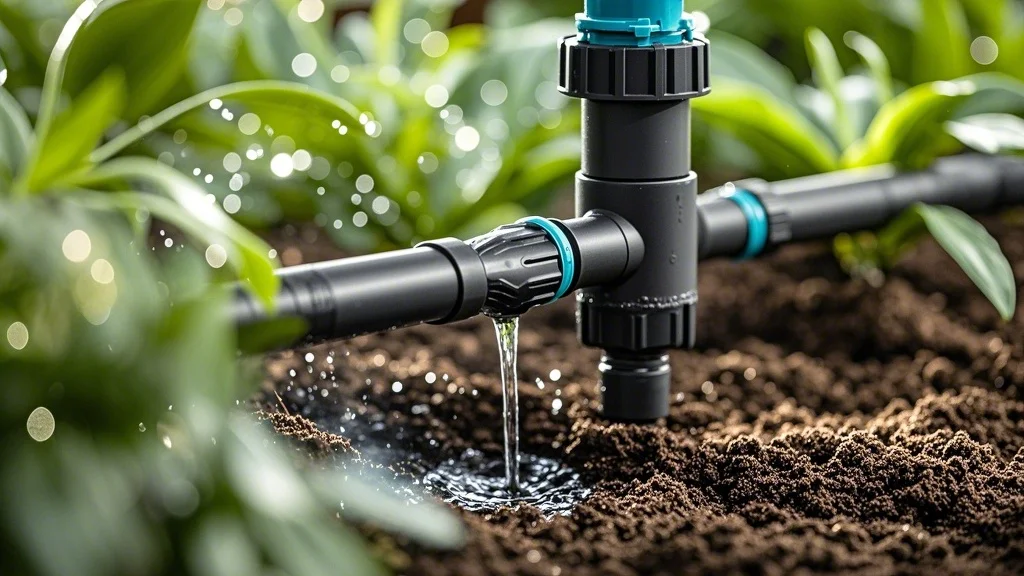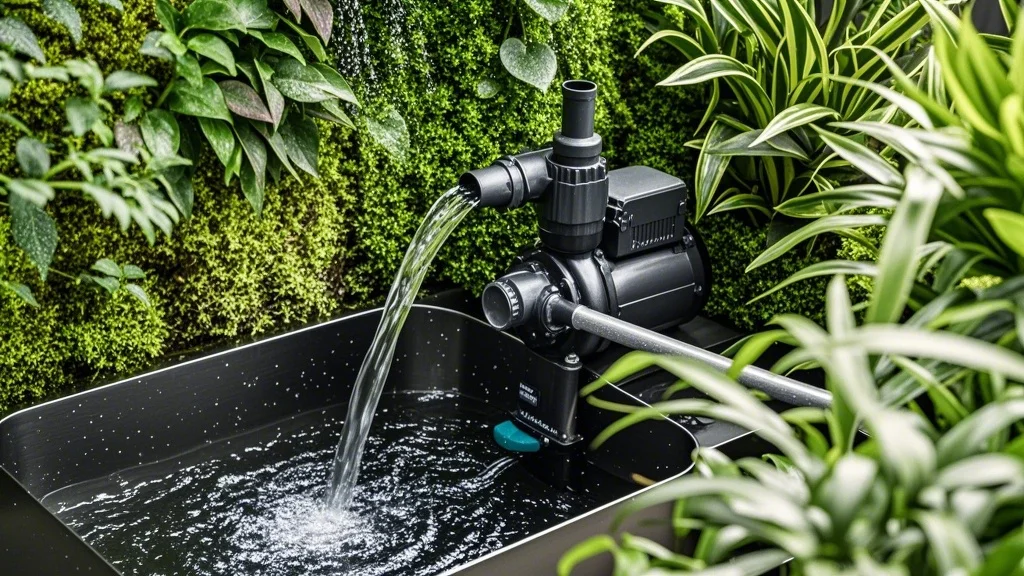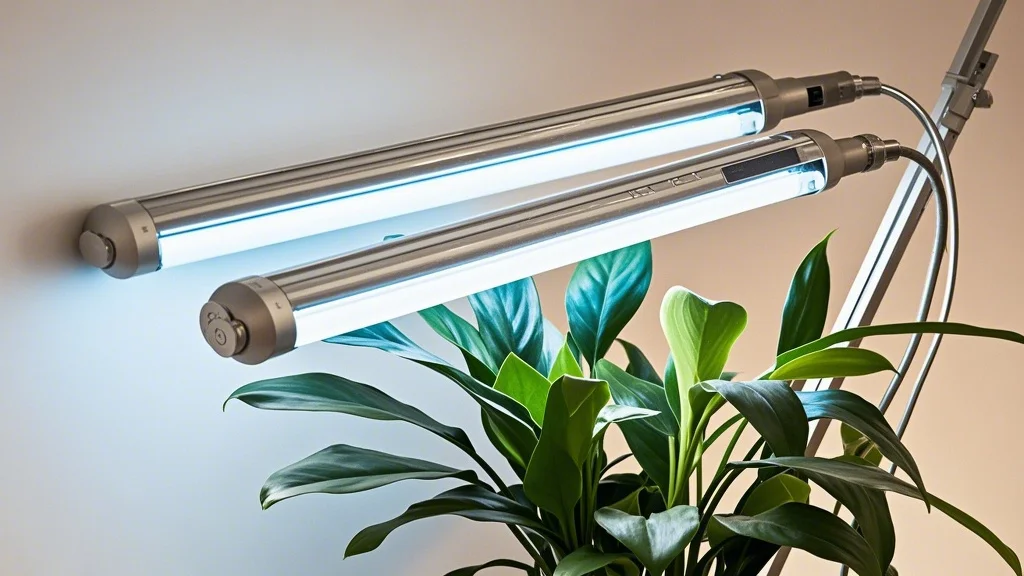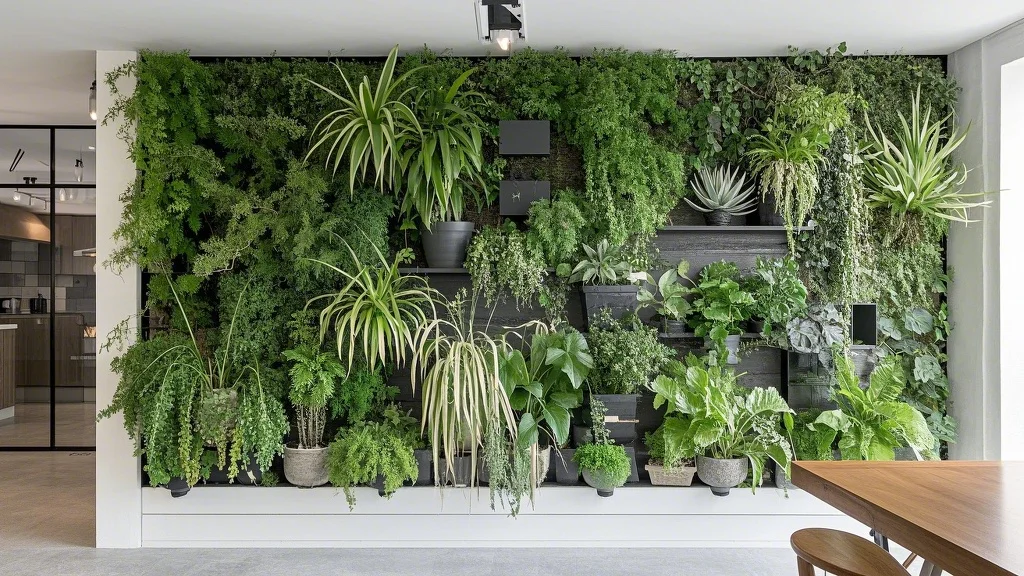Vertical gardens transform urban spaces into lush, living tapestries, but their beauty comes with a unique challenge: how to deliver water efficiently to plants growing on a vertical plane. Unlike traditional gardens where gravity helps distribute water evenly, vertical gardens require specialized irrigation solutions to ensure all plants receive adequate moisture without creating mess or water waste. This comprehensive guide explores the various irrigation systems available for vertical gardens, helping you select and implement the most effective watering solution for your living wall.
Contents
- 1 Understanding Vertical Garden Irrigation Challenges
- 2 Types of Irrigation Systems for Vertical Gardens
- 3 Automated Control Systems
- 4 Designing Your Vertical Garden Irrigation System
- 5 Installation Process
- 6 Maintenance and Troubleshooting
- 7 Advanced Considerations
- 8 Sustainable Approaches
- 9 Conclusion
- 10 Resources for Further Learning
Understanding Vertical Garden Irrigation Challenges
Before diving into specific systems, it’s important to understand the unique challenges of watering vertical gardens:
Gravity Effects
In vertical installations, water naturally flows downward, potentially oversaturating lower plants while leaving upper sections dry. An effective irrigation system must counteract this natural tendency.
Water Distribution
Plants in different positions on the wall may have varying water needs based on:
- Exposure to sunlight
- Air circulation patterns
- Plant species requirements
- Proximity to irrigation sources
Structural Considerations
The irrigation system must work with your vertical garden’s construction without compromising:
- Waterproofing of the supporting wall
- Structural integrity
- Aesthetic appearance
- Plant root health
Types of Irrigation Systems for Vertical Gardens

1. Drip Irrigation Systems
Drip irrigation is perhaps the most widely used and efficient method for watering vertical gardens.
How Drip Systems Work
Drip systems deliver water directly to plant roots through a network of tubes and emitters. Water flows through main supply lines, then through smaller distribution tubes that terminate at each plant with drip emitters.
Components of a Drip System
-
Main supply line: Typically 1/2-inch polyethylene tubing
-
Distribution tubing: 1/4-inch micro-tubing
-
Drip emitters: Available in various flow rates (0.5-2 gallons per hour)
-
Pressure regulator: Reduces water pressure to prevent blowouts
-
Filter: Prevents clogging of small emitters
-
Timer: Automates watering schedules
Benefits of Drip Irrigation
-
Water efficiency: Reduces water usage by up to 70% compared to traditional methods
-
Precision: Delivers water exactly where needed
-
Reduced disease: Keeps foliage dry, minimizing fungal issues
-
Customization: Can be tailored to individual plant needs
Installation Tips
- Position the main supply line along the top of your vertical garden
- Run distribution tubes vertically or in a grid pattern
- Place emitters directly at the root zone of each plant
- Use stakes or clips to secure tubing to the vertical structure
- Install the system before planting when possible

2. Recirculating Systems
Recirculating systems are ideal for larger installations and offer environmental benefits through water reuse.
How Recirculating Systems Work
Water is pumped from a reservoir at the base of the wall to the top, where it then trickles down through the growing medium, collecting in the reservoir to be reused.
Components of a Recirculating System
-
Collection basin/reservoir: Typically at the base of the wall
-
Submersible pump: Moves water from basin to top of wall
-
Distribution pipes: Deliver water across the top of the wall
-
Growing medium: Must balance water retention with drainage
-
Waterproof backing: Prevents water damage to supporting structure
-
Timer and controls: Manage pumping cycles
Benefits of Recirculating Systems
-
Water conservation: Reuses water rather than consuming fresh water with each cycle
-
Nutrient efficiency: Captures and reuses nutrients that would otherwise be lost
-
Even distribution: Creates consistent moisture throughout the wall
-
Reduced maintenance: Less frequent watering needed
Installation Considerations
- Ensure the collection basin is properly sized (minimum 2 gallons per 10 square feet of wall)
- Install a reliable waterproof membrane behind the system
- Use a pump with sufficient power to reach the top of your wall
- Include access points for cleaning and maintenance
- Consider including UV sterilization to prevent algae growth
3. Wick Irrigation Systems
Wick systems use capillary action to draw water from a reservoir to plant roots.
How Wick Systems Work
Absorbent materials like cotton rope, felt, or specialized wicking materials draw water upward from a reservoir to the growing medium through capillary action.
Components of a Wick System
-
Reservoir: Water storage container
-
Wicking material: Rope, felt, or specialized wicking fabric
-
Growing containers: Must allow contact between wick and growing medium
-
Growing medium: Should work well with capillary action (coco coir, peat, etc.)
Benefits of Wick Irrigation
-
Simplicity: No electricity or pumps required
-
Reliability: Few mechanical parts to fail
-
Low maintenance: Requires only periodic reservoir refilling
-
Energy efficiency: Operates without electricity
Limitations
- Generally suitable only for smaller installations
- Limited vertical reach (typically under 12 inches)
- May not provide sufficient water for high-demand plants
4. Misting and Spray Systems
Misting systems are ideal for certain plant types, particularly those that absorb moisture through their foliage.
How Misting Systems Work
Fine spray nozzles emit a mist of water that covers plant foliage and eventually reaches the growing medium.
Components of a Misting System
-
Supply line: Delivers water to the system
-
Misting nozzles: Create fine water droplets
-
Timer: Controls misting frequency and duration
-
Pressure regulator: Ensures proper mist formation
Best Applications
- Fern walls
- Moss installations
- Tropical plants that benefit from humidity
- Small herb gardens
Considerations
- Can create excess moisture in indoor environments
- May lead to water spotting on nearby surfaces
- Less water-efficient than direct root irrigation
- Often requires more frequent cycles
Automated Control Systems
Modern vertical garden irrigation can be enhanced with various control technologies:
Timer-Based Systems
The most basic automation uses timers to activate irrigation at set intervals.
Advantages:
- Simple to set up and use
- Relatively inexpensive
- Reliable operation
Limitations:
- Does not adapt to changing conditions
- May waste water during rainy periods
- Requires seasonal adjustments
Sensor-Based Systems
More advanced systems use sensors to determine when irrigation is needed.
Types of sensors:
-
Moisture sensors: Measure growing medium moisture content
-
Temperature sensors: Adjust watering based on heat levels
-
Light sensors: Coordinate watering with light cycles
-
Rain sensors: Prevent watering during or after rainfall
Benefits:
- Water only when needed
- Adapts to environmental changes
- Prevents over/under watering
- Significant water savings
Smart Irrigation Controllers
The most sophisticated option integrates with smart home systems and weather forecasts.
Features:
- WiFi connectivity
- Smartphone control
- Weather data integration
- Historical usage tracking
- Zone-specific programming
Considerations:
- Higher initial investment
- May require technical setup
- Dependent on internet connectivity
- Potential software updates needed
Designing Your Vertical Garden Irrigation System
Assessment Factors
Before selecting an irrigation system, evaluate:
-
Wall size and height: Larger walls require more robust systems
-
Plant selection: Different species have varying water requirements
-
Indoor vs. outdoor location: Affects water runoff considerations
-
Available water source: Proximity and pressure of water supply
-
Budget constraints: Both initial and ongoing operational costs
-
Maintenance capabilities: Your ability to monitor and maintain the system
Design Principles
Effective vertical garden irrigation follows these principles:
1. Zone Planning
Divide your vertical garden into irrigation zones based on:
- Plant water needs (high, medium, low)
- Sun exposure (full sun sections vs. shaded areas)
- Height (compensate for gravity effects)
2. Redundancy
Build in backup options:
- Secondary water delivery methods
- Manual override capabilities
- Failure notification systems
3. Accessibility
Ensure all components can be accessed for:
- Routine maintenance
- Filter cleaning
- Emitter replacement
- System modifications
4. Water Conservation
Incorporate water-saving features:
- Precision delivery methods
- Runoff collection
- Moisture sensors
- Appropriate timing
Installation Process
Pre-Installation Planning
- Create a detailed irrigation plan showing:
- Main supply lines
- Distribution lines
- Emitter locations
- Control system placement
- Water source connection
- Gather all materials and tools before beginning
- Test all electronic components before installation
Basic Installation Steps
-
Install the water source connection
- Add backflow preventer if required by local codes
- Install pressure regulator and filter
-
Mount the controller in a protected location
- Ensure electrical connections are weatherproof
- Position for easy access and visibility
-
Install the main supply line
- Typically along the top of the vertical garden
- Secure firmly to prevent sagging
-
Connect distribution lines
- Run lines to each planting section
- Use appropriate fittings to prevent leaks
-
Install emitters or nozzles
- Position directly at plant root zones
- Verify proper flow rate for each plant type
-
Test the system
- Check for leaks
- Verify water distribution
- Adjust emitter positioning as needed
-
Program the controller
- Set appropriate watering schedules
- Configure any sensor inputs
- Test automatic operation
Maintenance and Troubleshooting
Routine Maintenance Tasks
Weekly
- Visually inspect for leaks or blockages
- Check plant health for signs of water issues
- Verify proper system operation
Monthly
- Clean filters
- Check emitters for clogs
- Inspect tubing for damage
- Verify timer settings
Seasonally
- Adjust watering schedules for seasonal changes
- Flush the system to remove mineral buildup
- Check pressure regulator operation
- Inspect waterproofing integrity
Common Problems and Solutions
Clogged Emitters
-
Symptoms: Dry spots, uneven plant growth
-
Solution: Remove and clean emitters, consider installing a better filtration system
Leaking Connections
-
Symptoms: Water pooling, wet spots on wall
-
Solution: Tighten fittings, replace damaged components, use thread tape
Uneven Water Distribution
-
Symptoms: Some plants thriving while others struggle
-
Solution: Adjust emitter flow rates, reposition distribution lines, consider pressure-compensating emitters
System Failure
-
Symptoms: Complete lack of water delivery
-
Solution: Check power supply, verify water source, inspect for major leaks or blockages
Advanced Considerations
Water Quality Management
Water quality significantly impacts irrigation system performance:
-
Hard water: Can cause mineral buildup in emitters
- Solution: Install a water softener or use periodic acid flushes
-
Chlorinated water: May affect sensitive plants
- Solution: Use a dechlorination filter or let water stand before use
-
Recycled water: May contain particles that clog systems
- Solution: Implement robust filtration
Fertigation Integration
Combining fertilization with irrigation (“fertigation”) offers efficiency benefits:
-
Methods:
- Injector systems that introduce nutrients into irrigation water
- Slow-release fertilizer incorporated into growing medium
- Periodic manual application of liquid fertilizer through the irrigation system
-
Benefits:
- Even nutrient distribution
- Reduced labor
- Precise control of nutrient delivery
-
Considerations:
- May require additional filtration
- Needs careful calculation of nutrient concentrations
- Requires compatible fertilizer formulations
Sustainable Approaches
Rainwater Harvesting Integration
Connecting vertical garden irrigation to rainwater collection systems:
-
Collection methods:
- Roof runoff capture
- Rain barrel installation
- Cistern systems
-
Integration requirements:
- Filtration to prevent debris from entering irrigation
- Pump system to deliver water to vertical garden
- Overflow management for excess water
-
Benefits:
- Reduced water costs
- Environmental sustainability
- Often better for plant health than treated water
Greywater Systems
Using household wastewater for vertical garden irrigation:
-
Suitable sources:
- Shower and bath water
- Washing machine discharge
- Bathroom sink water
-
Implementation requirements:
- Proper filtration and treatment
- Compliance with local regulations
- Compatible plant selection (avoid edibles with some greywater sources)
-
Considerations:
- Use plant-friendly soaps and detergents
- Implement regular system cleaning
- Monitor plant health closely
Conclusion
Effective irrigation is the lifeline of any vertical garden. By selecting the appropriate system for your specific needs, implementing it correctly, and maintaining it diligently, you can ensure your living wall remains a vibrant, thriving feature. Whether you choose a simple drip system for a small indoor installation or a sophisticated recirculating system for a large exterior wall, the principles remain the same: deliver water efficiently to plant roots while minimizing waste and preventing damage to surrounding structures.
As vertical gardening continues to gain popularity in urban environments, irrigation technology will undoubtedly evolve to offer even more efficient and sustainable solutions. By understanding the fundamentals outlined in this guide, you’ll be well-equipped to adapt to these innovations and maintain a healthy, beautiful vertical garden for years to come.
Resources for Further Learning
- Books on vertical garden irrigation
- Manufacturer websites for specific components
- Local extension offices for region-specific advice
- Professional installation services
- Online forums and communities for vertical gardeners
Remember that the perfect irrigation system balances the specific needs of your plants, the constraints of your space, and your capacity for maintenance. With careful planning and implementation, you can create a watering solution that keeps your vertical garden thriving with minimal effort and maximum efficiency.









